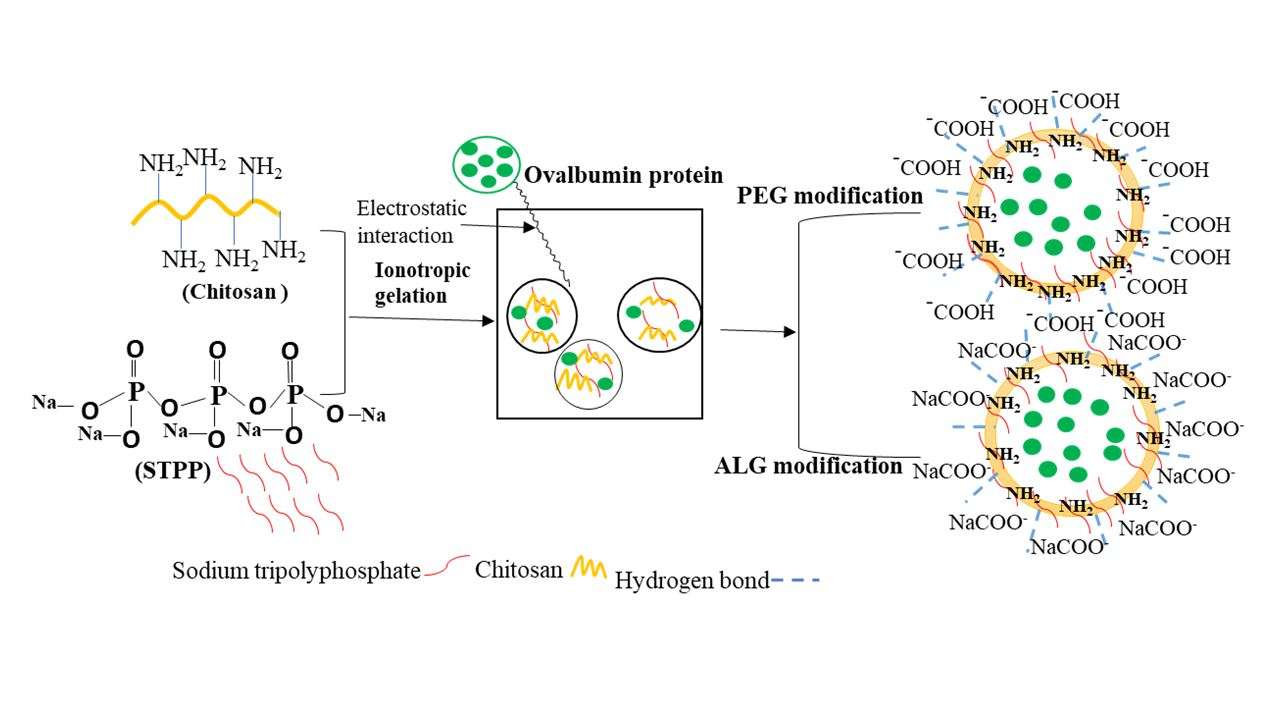Enhancing Stability and Mucoadhesive Properties of Chitosan Nanoparticles by Surface Modification with Sodium Alginate and Polyethylene Glycol for Potential Oral Mucosa Vaccine Delivery

Background: The present study aimed to fabricate surface-modified chitosan nanoparticles with two mucoadhesive polymers (sodium alginate and polyethylene glycol) to optimize their protein encapsulation efficiency, improve their mucoadhesion properties, and increase their stability in biological fluids.
Method: Ionotropic gelation was employed to formulate chitosan nanoparticles and surface modification was performed at five different concentrations (0.05, 0.1, 0.2, 0.3, 0.4% w/v) of sodium alginate (ALG) and polyethylene glycol (PEG), with ovalbumin (OVA) used as a model protein antigen. The functional characteristics were examined by dynamic light scattering (DLS), X-ray diffraction (XRD), Fourier-transform infrared spectroscopy (FTIR), differential scanning calorimetry (DSC), and scanning electron microscopy (SEM)/scanning transmission electron microscopy (STEM). Stability was examined in the presence of simulated gastric and intestinal fluids, while mucoadhesive properties were evaluated by in vitro mucin binding and ex vivo adhesion on pig oral mucosa tissue. The impact of the formulation and dissolution process on the OVA structure was investigated by sodium dodecyl-polyacrylamide gel electrophoresis (SDS-PAGE) and circular dichroism (CD).
Results: The nanoparticles showed a uniform spherical morphology with a maximum protein encapsulation efficiency of 81%, size after OVA loading of between 200 and 400 nm and zeta potential from 10 to 29 mV. An in vitro drug release study suggested successful nanoparticle surface modification by ALG and PEG, showing gastric fluid stability (4 h) and a 96 h sustained OVA release in intestinal fluid, with the nanoparticles maintaining their conformational stability (SDS-PAGE and CD analyses) after release in the intestinal fluid. An in vitro mucin binding study indicated a significant increase in mucin binding from 41 to 63% in ALG-modified nanoparticles and a 27–49% increase in PEG-modified nanoparticles. The ex vivo mucoadhesion showed that the powdered particles adhered to the pig oral mucosa.
Conclusion: The ALG and PEG surface modification of chitosan nanoparticles improved the particle stability in both simulated gastric and intestinal fluids and improved the mucoadhesive properties, therefore constituting a potential nanocarrier platform for mucosal protein vaccine delivery.
Download the full article as a PDF here or read it here
Article information: Amin, M.K.; Boateng, J.S. Enhancing Stability and Mucoadhesive Properties of Chitosan Nanoparticles by Surface Modification with Sodium Alginate and Polyethylene Glycol for Potential Oral Mucosa Vaccine Delivery. Mar. Drugs 2022, 20, 156. https://doi.org/10.3390/md20030156

